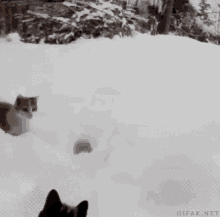
raindancewx
Members-
Posts
3,757 -
Joined
-
Last visited
About raindancewx

Contact Methods
-
Website URL
https://t.co/wsurUGcxYv?amp=1
Profile Information
-
Gender
Not Telling
-
Location:
Albuquerque
Recent Profile Visitors
26,522 profile views
-
More bullshit Spring weather today. Mid-40s for highs, low elevation rain, graupel, thunder, no snow in town. Even at 5,600 feet I saw some accumulating snow today just outside town. Mountains look amazing with the strength of the April sun, rainbows, and then a fresh coat of heavy snow. Canadian has a fall peak for a pretty healthy La Nina. It weakens the event east-west, which means a pretty active March is already likely next year.
-
My Winter Outlook for 2023-24
raindancewx replied to raindancewx's topic in Weather Forecasting and Discussion
Snowfall distribution has been fairly interesting so far for the cold season. The fluky snow in the South looks like it will hold. Have to see if the late season Nor'easter verifies. Couple more big storms for the West too through 4/15 before I can really analyze if the snow outlook was good. March has eaten away at some of the snowfall deficits nationally. It's been a very snowy month for most of the West, although shifted somewhat north of March 1973 unfortunately. Late March 1973 had the big snows by WI as well if I remember right. Taos Powderhorn (11,000 feet up) locally went from ~40" at the start of March, which is pretty low, to 74" the other day for snow pack. So it's been a good month for the West. That site tends to peak around 60 inches in March. -
We're nearing the end of that fabulous period in the Rockies I call "bullshit Spring". It runs from 2/15-4/15. High elevation zones often get smoked with heavy snow, high wind and frequent rapid temperature changes. Once 'bullshit Spring' ends the next item to look for is when heat arrives in the Southwest. La Ninas that see early heat in Albuquerque (90F by 5/10 or so) tend to be relatively cold winters in the Southwest with more frequent cold waves. Given the harmonic tendencies of recent months, I actually think May could be fairly cold here. We've actually not hit 70F yet here, even though late March average highs are about 65F. I was checking some observations in the highlands of Mexico the other day. Nino 1.2 has flipped negative v. averages. Typically the vacating of excess heat in that zone accompanies unusually dry air getting fairly close to the equator. I saw some dew points as far South as 15-20N in the teens (F) in recent days. Normal dew points are ~40(F) ish in that area of the world in March.
-
The PDO continues to reverse from pretty negative despite the El Nino falling apart. That's worth watching. The +PDO La Ninas are an interesting bunch. +PDO tends to be cold East, La Nina tends to be cold North. It's the opposite of last winter where -PDO tends to be cold West, and El Nino tends to be cold South. Years like 1995-96 and 2017-18 are +PDO La Ninas. I see some indications that the WPO may flip pretty negative in the Fall. That's often accompanied by early Fall snows nationally, but we'll see how that goes.
-
The El Nino finished at ~28.4C in Nino 3.4 for Dec-Feb. The years most similar to that were 1957-58, 1972-73, 1982-83, 1991-92, 1997-98, 2009-10. The roll forward is very much a Modoki La Nina look if you throw out 1958 and 1992 which are not La Ninas. 1973-74, 1983-84, and 2010-11 are actually pretty interesting winters with pretty severe cold shots at times in places you wouldn't expect given the overall patterns. I believe 1983-84 and 2010-11 had TX power grid destroying cold shots / Blue Northers.
-
We seem to be entering the March 1973 part of the pattern now. After 10 feet of snow in California's high terrain in two days earlier this month, I suspect our mountains will get 1-3 feet in 1-2 days with this storm. I don't think it's the last one either. I would prefer to have a stout cold high in Wyoming trapping a flow of moisture from Puerto Penasco, but trapping a strong storm with a lot of moisture and some cold for a long duration under a high isn't half bad. If any of you still need your snow fix, our mountains will get pasted with this setup even though it's not as good as the Casper v. Penasco setup. I'm a little surprised this didn't happen in December or January, but these types of regimes tend to accompany the transition from East based to Modoki setups. If you look, the thunderstorm activity has kind of died in the East Pacific in recent days / weeks. It makes sense that it looks fairly cold in the East now. I would bite on this being a Modoki El Nino from now until it completely collapses into an East based La Nina in six weeks.
-
My Winter Outlook for 2023-24
raindancewx replied to raindancewx's topic in Weather Forecasting and Discussion
It looks like I had the right general idea for temperature and precipitation profiles seasonally, but not monthly. Warmth was more impressive than I expected too. But I had the warmest part of the US as MO to MN and east, and that verified. No one was expected to be cold overall, which verified, but coolest spots South and West. Dry spots in an ocean of above average moisture were generally placed correctly too. I'll do a more in-depth update on snow once the March snows settle down late March into April. -
I've always found it a bit silly to look for a 500 mb profile in ENSO that is typical, and to complain that anything that doesn't match that profile is atypical. It's much more common for ENSO events to go to a temperature profile that matches the typical / atypical idea in comparison to the 500 mb profile. You essentially had the normal warm North / cool South look from this El Nino, regardless of how you got to it, plus maybe a bit more coolness for the Northwest with the -PDO. I'd be more willing to agree with your assessment if the subtropical jet had failed to be strong. But that actually is a direct physical response to ENSO, and it was there. The mid-lattitude stuff that people look for is essentially over fitting trend lines and history in a lot of ways.
-
Remember how I said there would be an incredibly powerful storm around March 1? Check out the blizzard over California the past two days. Welcome to March.
-
What Went Wrong in Winter 23-24/Base State/Will It Ever Snow Again??
raindancewx replied to WxUSAF's topic in Mid Atlantic
I doubt the models really have the orientation of SSTs right for next winter. It could definitely be very warm out here for 2024-25. But truth be told, a lot of the Modoki La Ninas are pretty good for snow out here. The Modoki El Ninos and Modoki La Nina both tend to see one of the dominant ENSO signs fail more often than the east-based events. The El Nino signs here are ~70% cold / ~70% wet, and the La Nina signs here are ~70% warm / ~70% wet. In Modoki El Ninos a lot of times the wet signal fails in winter (see: 1957-58, 2009-10, etc), and in Modoki La Ninas a lot times the warm signal fails (1974-75, 1984-85, 2000-01, 2020-21, 2022-23). One other thing that's lost is that La Nina tends to amplify the temperature differentials in the mid-latitudes by enhancing dry air. So here in the desert, with drier air and more sunshine, we tend to have very cold nights in a lot of -PDO/La Nina setups. In El Nino, moist air is abundant and the mid-latitudes have lower temperature differential v. the tropics, so we tend to have a lot of warm nights and cold highs. The caveat to that is that enhanced snow and snow cover duration offsets the warm nights. The 2022-23 La Nina had something like 112 nights with lows that were freezing or colder from Oct-May. That's a pretty severe winter by lows for us - even though the highs were not cold. Whether any of you believe me or not, there is a real tendency for the West to face incredible periods of severe cold in La Nina following years of low hurricane activity in the Atlantic. All of our record cold events, even in the Southwest are in La Nina. Look at February 2011, November 2000, January 1971, etc. La Nina climatology for the Southwest is persistent warmth, like 70 of 90 days that are +3 or more, with 20 or so days that are -5. The "harsh" La Ninas just have the 20, or 30 cold days at -10 or -20 v. means instead of -5. So you're really just trying to predict the harshness and duration of the brief cold periods. -
Google is your friend. https://tropical.atmos.colostate.edu/Realtime/index.php?arch&loc=northatlantic
-
Canadian is a bit different from the CFS. The absence of heights by Japan is a major change from the winter and should come with some colder systems and/or late Nor'easters for the East Coast.
-
Google is your friend. https://psl.noaa.gov/data/correlation/wp.data
-
I'm not crazy for thinking the CFS has March 1973 right? I mean...that's an insane month for the West if it even comes to verifying. Top five for snow in the past 100 years I'd guess regionally. It does look like the North Pacific high pressure feature is off in terms of placement east/west, and maybe a touch north of 1973. But it really does look close to March 1973 to me. At this range, the CFS actually has skill for the next month too. It's done pretty well this winter actually.
-
Just for future reference - the area of the world that was coldest (v. local means) this winter was NE Russia. Looks very much like the WPO drove the winter pattern in Asia and North America as much as anything.









